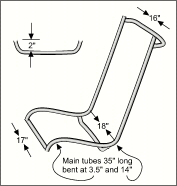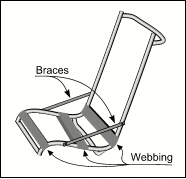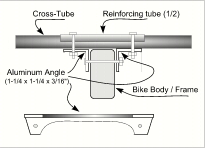
http://www.manytracks.com/recumbent/seat.htm
Instructions
- 1Cut the conduit to the appropriate lengths. The sides will start out at 36 inches long, and will be made from the 1/2 inch tubing. The seat stretchers will each be 24 inches long and made from the 3/4 inch tubing. Cut each piece of tubing in half, then clean the cut ends with a file.
- 2Bend the conduit pieces to form the seat sides. Each side will have to be bent exactly the same way, and each bend should be made in plane. First, bend one of the 36-inch pieces 45 degrees at the end so the center of the bend is at about 4 1/2 inches. Next, bend the conduit 90 degrees in the opposite direction, with the bend centered 12 1/2 inches from the end. Then, make two 15-degree bends in the same direction as the first bend, centered at 19 1/2 and 22 1/2 inches from the end. Finally, bend 20 degrees opposite the initial bend, centered at 28 3/4 and 32 1/4 inches. Perform the same bends on the other one.
- 3Bend the conduit pieces to form the seat stretchers. Bend one 3/4 inch conduit piece 60 degrees, centered 6 inches from one end. Do the same bend, in plane and in the same direction, 60 degrees and 6 inches from the other end. Perform the same two bends on the other piece to form a second seat stretcher.
- 4Braze the seat together. Connect the ends of one of the seat stretchers to the seat sides, centered between the 90 degree and 45 degree bends, approximately 8 inches from the end, keeping the seat sides in plane with one another. Connect the other seat stretcher between the adjacent 15 and 20 degree bends, about 25 1/2 inches from the end. Make fish mouth cuts on the ends of the seat stretchers to fit them to the seat sides, then braze each connection.
- 5Attach the fabric cover to the seat. The fabric comes 54 inches wide, so cut it in half to form two 36 inch by 27 inch pieces, one of which will be used for this seat. Center the fabric on the seat so the long dimension goes along the vertical axis of the seat. Fold the ends over the sides of the seat, cutting where the seat stretchers are so as to fold around them, then hold them in place with the straight needles. Sew, using the fishing line, keeping as close to the seat rail, and maintaining as much tension on the seat as possible.
- 6Finish sewing the seat together. Cut along the seat rails to remove the excess fabric, then trim the extra fabric at the ends, leaving about 1 1/2 inches of fabric at either end. Fold each end over, and sew a seam at the top and bottom of the seat, again taking care to maintain the tension in the seat.
- 1
| The seats on both Woody & TreeBike were constructed of salvaged 7/8" OD aluminum CB antenna tubing. The main tubes were cut to 35" and bent on a borrowed, hand operated tubing bender as shown in the drawing. The front edge was joined by a straight tube and the other two cross-tubes were bent to allow 2" of clearance below and on the back of the seat.The dimensions given are for Woody's seat. Sue's is similar but main tubes were bent at 3" and 13". Seat width is 1" narrower all around. | |
 | I used a 7/8" Milwaukee hole saw to cut the ends of the tubing to nice tight fitting joints. |
If I were to do the job over again I would take the seat parts, assembled in a jig, to someone who does a good job welding aluminum. What I did was solder all of the joints into massive globs and then endlessly grind the mess down toa reasonably smooth joint. There is a fine line between smooth, good looking joints and weak, useless joints. The solder I used is MG Welding Products' 'MG 470", described as a 'Maximum strength self fluxing solder for joining, build-up and hardfacing aluminum'. I believe that the 1/8" diameter rods cost around $35 for two pounds.
 |
I added a couple of aluminum tubing braces after the first test ride. The seat reclined more with each hard pedal stroke due to the weakness of the main tubing. The braces are pop-riveted on and covered with shrink-wrap. As it turns out they give a more secure feeling by providing some lateral support and are not a problem when getting on and off the bike.
|
Seat supports were made by sewing loops in each end of lengths of 1" nylon webbing as shown above. These straps were then wrapped around the frame and secured with heavy-duty plastic wire ties. You can adjust the amount of support by repositioning the straps or adjusting the tension on the ties. More or fewer support straps can be used as needed. |
The seat material is nylon mesh and Cordura nylon fabric purchased from an upholstery/tent & awning shop. The mesh was cut to fit inside the frame with 1" space all around. Then 3-1/2" strips of Cordura were folded over the edges of the mesh and sewn on as edge reinforcement. Using a piece of 1/4" steel rod and a propane torch, I heated the rod and melted holes at 2" intervals along both sides. This creates holes that are self-finished and very strong. Finally, 1/4" brass gromets were installed in the holes for further reinforcement. The seat was laced into the frame using some approx. 1/8" diameter shiny polyester cording purchased from a fabric shop.
|
 |
The seat mounts to the frame with two pieces of aluminum angle which run between the front and bottom cross-tubes. I cut out a lot of the angle material to reduce weight.
Speaking of weight, this seat, complete with mounting as shown and with fabric and lacing weighed in at less than 3 1/2 lbs.
|
 |
Three of the four open ends of tubing were finished by epoxying in short lengths of 3/4" wood dowel then rounding the ends. This was done as a safety measure. While testing Woody I tipped over while hardly moving and 'apple cored' my ankle. Not a pretty sight even today.
At left you can see how the top left tube was finished. A longer dowel was first drilled to the size of a light-weight fiberglass sectional tent pole, then glued into the tube like the others. A little sewing of some bright yellow ripstop material and the safety flag was done. These bikes are low and don't present a very large or recognizable picture to car drivers. The flags are something drivers are used to associating with bikes ... and they make me feel a bit more visible.
|
Total cost per seat, not counting labor, was less than $35. I hope this information helps you construct your own recumbent bike seat - or decide not to, as the case may be. These seats have worked well for us. If you have any questions or comments please contact me.
Tips & Warnings
- When bending the conduit for the seat rails, make the corresponding bend on each piece before moving on to the next bend. This way, you can make sure that the bends all line up when it is easier to fix, before all the bends are made.
No comments:
Post a Comment